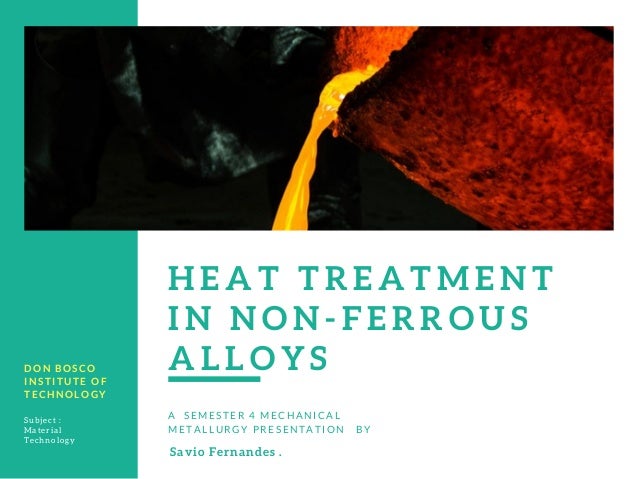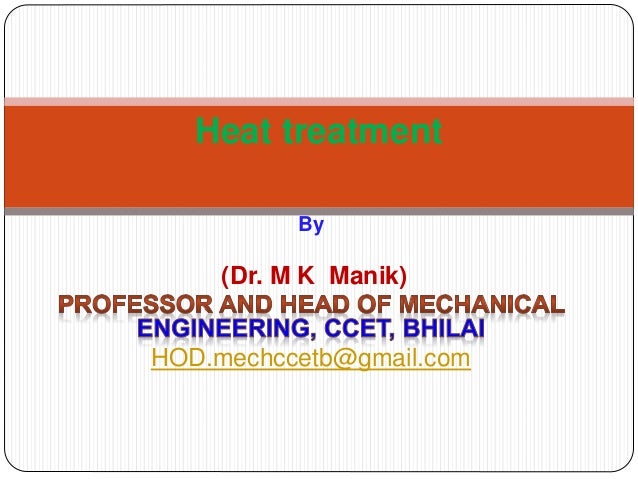Heat Treatment Of Non Ferrous Metals Ppt
METAL CLASSIFICATION All metals may be classified as ferrous or nonferrous. Most often these are then cooled very quickly to produce a martensite transformation putting the solution into a supersaturated state.
 Heat Treatment In Non Ferrous Alloy
Heat Treatment In Non Ferrous Alloy
Pure Al - Metallurgical 995998 Al - Refined up to 999 Al Al 999 Rm 70135 Nmm2 Work hardening of Al Conditions designations O annealed H work hardened degree of hardening H1-H9 W quenched T quenched and aged T1-T9 5 Non-ferrous metals and alloys.

Heat treatment of non ferrous metals ppt. Heat treatment of non ferrous metals. Heat Treatment of Metals Introduction. It is ductile malleable and nonmagnetic.
Heat Treating of Metals Pruthvi Loy Chiranth B. Process of hardening of steel is shown Heating the metal Shocking up to a predetermine time and quenching in a media as per defined process as shown. Annealing Normalizing Case hardening Precipitation strengthening Tempering Austempering Mar tempering.
The most important heat treating process for non-ferrous alloys is age hardening or precipitation hardening figure 98. Aluminum combined with various percentages of other metals generally copper manganese and magnesium form the aluminum alloys that are used in aircraft construction. This condition in age-hardenable alloys 2000 6000 and 7000 series is arrived at by soaking at a setpoint below the solution-treating temperature followed by a controlled slow cooling typically to 500F 260C.
Most non-ferrous alloys are also heated in order to form a solution. Weldability deteriorates with increasing C. A metal is nonferrous if.
Lution heat treatment or in which the effect of cold work in flattening or straight ening is recognized in mechanical property limits T4 Solution heat treated and naturally aged to a substantially stable condition. They are generally more expensive than ferrous metals Non-ferrous metals are used because of desirable properties such as low weight eg aluminium higher conductivity eg copper non-magnetic property resistance to corrosion eg zinc. As is true for most heat treating operations precipitation is a function of time and temperature.
4 SJEC Mangaluru 631 Full Heat Treatments 631a Annealing Annealing is a heat treatment process wherein the metal is heated above recrystallization temperature held at that temperature for certain duration so as to homogenize the temperature. Good combination of strength and ductility Yield strength. It is carryout to increase the tensile strength of nonferrous alloys changing them into a solid solution and controlling the rate of returning to a change structure of their mechanical mixture.
Indeed full-service heat treatment facilities toughen soft non-ferrous components too. A ferrous metal has iron as its main element. In my previous article I have explained The 3 Stages of Heat Treatment Process.
25 Strengthenable by heat treatment 04 carbon steel Weldable. A non-ferrous metal is any metal including alloys that does not contain iron in appreciable amounts. Veer Surendra Sai University of Technology - VSSUT.
The ductility can be enhanced by reducing the descent in temperature as a function of time. Heat treatment of Al-alloys 1. Metal and heat-treating techniques refer to TM 43-0106.
HEAT TREATMENT OF NONFERROUS METALS ALUMINUM ALLOYS Aluminum is a white lustrous metal light in weight and corrosion resistant in its pure state. Applies to products that are not cold worked after solution heat treatment or in. Heat Treatment process of controlled heating and cooling of metals Alter their physical and mechanical properties without changing the product shape sometimes takes place inadvertently due to manufacturing processes that either heat or cool the metal such as welding or forming.
4 Non-ferrous metals and alloys. Heat treatment processes are as follows. A metal is still considered ferrous even if it contains less than 50 percent iron as long as it contains more iron than any other one metal.
Thats another way of saying the techniques used here arent just used to harden ferrous workpieces. Medium-carbon steels structural steels 025-055C. Used for load-bearing applications crankshaft bolts gears heavy-duty machinery mining equipment cranes.
911 Ferrous materials Ferrous materials are produced in larger quantities than any other metallic material. Heat treatment science employs an equal opportunities approach to the field of metal strengthening. For each alloy there is an optimum time and temperature.
In order to apply this heat treatment the equilibrium diagram must show partial solid solubility and the slope of the solvus line must be such that there is greater solubility at a higher temperature than at a lower temperature. Strengthening by heat treatment involves either precipitation hardening or martensitic transformation both of which constitute specific heat treating procedure. When a material can not be strengthened by heat treatment it is referred as non-heat-treatable alloys.
Heat Treatment Heat Treatment process is a series of operations involving the heating and cooling of metals in the solid state. For the majority of nonferrous alloys this is from about 325650 F 165345 C although some alloys require higher aging temperatures. The common process of heat treatment of ferrous metals include hardening tempering annealing normalizing and case hardening.
 Heat Treatment Of Non Ferrous Metals And Alloys By Jitendra Ppt Download
Heat Treatment Of Non Ferrous Metals And Alloys By Jitendra Ppt Download
 E Liked This Presentation If You Wish To Download It Please Recommend It To Your Friends In Any Social System Sha Welding Projects Blacksmith Projects Alloy
E Liked This Presentation If You Wish To Download It Please Recommend It To Your Friends In Any Social System Sha Welding Projects Blacksmith Projects Alloy
 Heat Treatment Of Ferrous And Nonferrous Metals
Heat Treatment Of Ferrous And Nonferrous Metals
